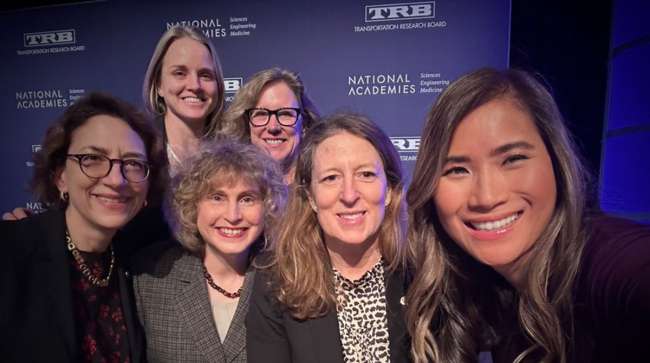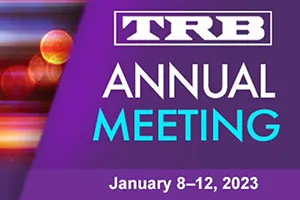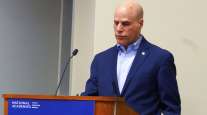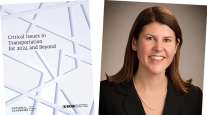Senior Reporter
DOT Leaders Provide Update on Safety System

[Stay on top of transportation news: Get TTNews in your inbox.]
WASHINGTON — A panel of top Department of Transportation leaders updated a session at this year’s meeting of the Transportation Research Board, outlining some of the activities aimed at reducing the continuing challenges of rising highway fatalities.
“We are in a crisis, particularly that after decades of improvements, we’ve seen these changes more recently as the numbers are moving in the wrong direction,” Emily Schweninger, DOT’s senior policy adviser for transportation health and safety, said Jan. 6 at the annual event that brings together thousands of transportation professionals, researchers and academics. “It’s been made very clear by the secretary that the crisis is very urgent, that it’s unacceptable, but that we have an opportunity to make a change.”
The Biden administration’s answer to the number of fatal crashes is the National Roadway Safety Strategy, a “comprehensive approach” that DOT called an immediate response.
The DOT’s “safe system approach,” formally adopted in January, has identified actions that are going to have immediate impacts on the crisis, Schweninger said.

“In addition to this, we’ve had this tremendous opportunity with the bipartisan infrastructure law in leveraging this once-in-a generation investment in thinking how we can piece all of these things together to make our roadways safer,” Schweninger added.
Federal Motor Carrier Safety Administrator Robin Hutcheson said DOT agencies are taking a “multidisciplinary [approach to] safer people, safer vehicles, safer speeds, safer roadways and post-crash care.”
“We want to figure out what works,” Deputy DOT Secretary Polly Trottenberg said. “We want to challenge ourselves. We want to really own the problem. Accountability is really going to be our buzzword. We know that our stakeholder community will really hold our feet to the fire. We want you to.”
The NRSS is our Department's comprehensive approach to substantially reducing severe injuries and deaths on our highways, roads, and streets.
Today's panel focused on implementation of our Safe Systems Approach and reaching our long-term goal of zero roadway deaths. pic.twitter.com/A5QANvFRhG — TransportationGov (@USDOT) January 9, 2023
Hutcheson said the agency is working on a speed limiter rule, plans to ensure that problem drivers can’t move from state to state and a joint automatic emergency braking rule with the National Highway Traffic Safety Administration. It also has added a provision requiring that rear impact guards be a required inspection item.

What is the outlook for trucking in 2023? How will the industry change with the current government, economic and business trends? Join host Michael Freeze and TT reporters Eugene Mulero and Connor Wolf. Hear the program above and at RoadSigns.TTNews.com.
In addition, Hutcheson said the agency is studying crash causation, truck driver compensation structures that could be resulting in high turnover rates, detention time waits at terminals, predatory practices in truck leasing, and assessing why there are too few female truck drivers.
“One of the things that is extraordinarily important for us as political appointees is to make sure that the work we do today lasts,” said Ann Carlson, acting NHTSA administrator. “We have a lot of career folks here today who have really leaned in to the safe system approach and are talking to each other across modes, not just up through the modal leadership. Responsibility is shared across the department, across the employees of the department, and it’s shared with our state partners.”
Want more news? Listen to today's daily briefing above or go here for more info
Carlson added, “But I do want to stress one thing about the vehicle safety side. It takes a long time for regulations to not only get enacted, but to actually affect the vehicle. We sometimes think when we pass a rulemaking, we’ve solved the problem of rear-end crashes because we have automatic emergency braking now on light-duty and heavy-duty vehicles. But as you know, a vehicle fleet turns over very slowly.”
Trottenberg agreed that the DOT has to be accountable for the challenges its leaders face. “Part of that accountability means being very transparent about the data, about the actions we’re taking, about what’s working and not working,” Trottenberg said. “Part of that is going to be a partnership with all the people in this space.”
The same day the leaders were discussing their safety plans, NHTSA released its latest projections for traffic fatalities in 2022. It estimated that 31,785 people died in traffic crashes in the first nine months — a 0.2% decrease compared with 31,850 during the same period in 2021.




